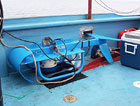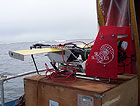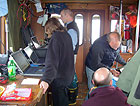

 | |||||||||||||||||||||
|
|
Journals 2006/2007Kirk Beckendorf
August 30, 2006 This afternoon we were off Point Barrow itself, not the town but the actual spot that is the most northern piece of land in the United States. Carin pointed out the monument on shore marking the spot. Just as I was about to take a picture someone yelled, "whale"!!! Not far from the boat, two gray whales were surfacing, blowing and turning on their side sticking their fins out of the water. Very cool I never did get a picture of the monument, but I did get several lousy pictures of the whales. The plan for the afternoon was to start near the Point, put a couple of instruments in the water, head basically north towing the instruments and then work our way back to the Point taking samples along the way. The first device we put in the water is called an Acoustic Doppler Current Profiler, which is why everyone just calls it the ADCP. It has a big blue frame, but the actual working part is a rather small white and blue round disk hanging under the frame. The blue frame just allows the ADCP to easily flow through the water. The disk sends signals down into the water to detect and map any ocean currents. Hanging from a rope the ADCP stays below the surface. A computer cable runs to a laptop computer inside.
The second instrument we put in the water is called the Acrobat. It can be programmed to adjust its yellow wings to "fly" up and down through the water as it is pulled behind the boat. As the Acrobat "flies" up and down through the water it sends real-time data to Bob's laptop. Some of the measurements it makes include water temperature, salinity, organic matter and chlorophyll levels.
Among other things, the data obtained from the Acrobat can be used to decide where to sample in more detail. As Steve, the physical oceanographer, has told me, ocean water is not uniform; it is not the same all of the way through. The ocean has currents of water, pockets of water and layers of water. These "parcels of water" can have different amounts of salt, different temperatures, different amounts of chlorophyll and they will have come from different places. In one of his computer programs different bodies of water show as different colors.
Imagine a bowl filled with just vanilla ice cream and a second bowl filled with vanilla and chocolate ice cream plus some chocolate syrup, caramel syrup and throw in some strawberries. No matter where you look in the bowl of vanilla it will be the same. This would certainly not be true with the second bowl. With all of its different layers the second bowl is more like ocean waters. Except of course, unlike the ice cream, the ocean water is always moving. The layers and sections of water are constantly moving, mixing and changing. The ADCP and the Acrobat are two of the tools used to find where these different "chunks" and streams of water are located, where they are going and what is in them. The temperature, salinity and source of the water help determine the kinds and amounts of plankton in the water. Since plankton are the basis of the food chain the characteristics of ocean water will have a large impact on the organisms at the top of the food chain, like the whales we saw today. Question of the Day: What will the amount of chlorophyll in the water tell you? |
||||||||||||||||||||




